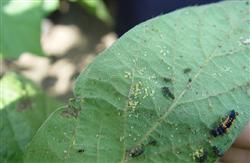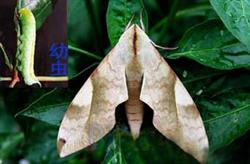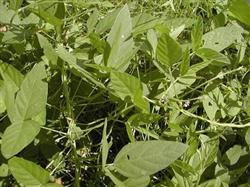When to control soybean heart-eating insects?

When to control soybean heart-eating insects? Please introduce that soybean heart borer is the main pest in soybean production, with a feeding rate of 5% to 10% in general years and as high as 30% to 60% in severe years. The damaged beans not only reduce the yield, but also deteriorate the quality. By mastering the control period and methods of soybean heart-eating insects, the insect-eating rate can be controlled below 2% to 3%. Soybean heart borer occurs one generation a year and overwinters with mature larvae in the soil. In late July of the following year, it floated to the topsoil to pupate. Eclosion began at the end of July and the beginning of August, and the peak period of Eclosion was in the middle of August. After mating, the adults laid eggs on the tender pods, and the eggs hatched into larvae after 6-7 days. The larvae crawled on the pods for several hours before entering the pods. The larval stage was 20-30 days, and the pods began to fall into the soil in September. 1. To control and control the peak period of adult occurrence, we should first make a good prediction and forecast. The number of adult moths is investigated every day before sunset in the afternoon from the beginning of August. When the number of moths in the field suddenly increases, the phenomenon of clumping is the peak period of adults (from August 12 to 1.8 in most years). Prevention and control methods: first, dichlorvos stick fumigation. Cut the corn cob or sunflower stalk into about 5 cm long with 100 ml of dichlorvos EC per mu, soak in dichlorvos solution, press the density of 1 stick of 5 meters every 4 ridges, clip the stick on the soybean branch. This fumigation method is suitable for soybean fields with luxuriant growth and covered ridges, and the control effect can reach more than 90%. The second method is spray. Spray the spray head up from the bean root with 25% Kuaishaling EC or other pyrethroids per mu with a knapsack sprayer per mu of water, so that the lower branches and leaves and top leaves are sprayed on the back. No matter how the soybean grows, this method is very effective in preventing and controlling adults. Second, after the larvae hatched to control the soybean heart borer before entering the pod, the time of crawling on the pod was generally no more than 8 hours. It's a hard time to master. Therefore, the control of larvae must be investigated in the field, and the medicine can be administered when the eggs are seen on the soybean pods. Pyrethroids are generally used to spray water to control larvae. Spray evenly, especially in pod-bearing areas. The effect of this method on controlling larvae is about 80%. Third, the control of soybean after harvest generally enters the harvest in September, at this time, some heart-eating insects have not shed their pods. If they are not threshed in time, the heart-eating insects can continue to do harm in the pods and gradually remove their pods and enter the soil one after another. Before entering the yard during the soybean harvest period, wet the soybean bottom soil with 1500 times EC or other insecticides, the wet soil layer is about 3 cm deep, then compacted with wood, and then stacked on top of the recovered soybeans, so that the podding heart borer can be killed in the medicine soil layer at the bottom of the stack. The control methods commonly used after soybean harvest are as follows: first, threshing while harvesting, which can prevent heart-eating insects from continuing to do harm in pods after harvest. The second is to apply pesticide at the bottom of soybean stack before harvest to reduce the source of insects next year. The third is to carry out autumn turning and autumn raking in the bean field to destroy the overwintering place of heart-eating insects that fall off their pods before harvest and increase the mortality rate. Click to get more soybean planting technology click to get more grain and oil crop planting technology
- Prev

How does planting soybean prevent and control bean moth?
How does planting soybean prevent and control bean moth? Please introduce the big bean moth: harm symptoms bean moth to larvae feeding leaves, young larvae eat into mesh and notch shape, three instars after the larvae can eat all the bean leaves, so that the plant can not bear pods, for the yield of great impact. From mid to late July to August...
- Next

How to prevent low yield from planting soybeans?
How to prevent low yield from planting soybeans? Please give guidance in the current agricultural production, growing soybeans basically do not apply fertilizer (especially in summer soybean producing areas). The main reason is that most people think that soybeans can fix nitrogen, grow soybeans without fertilization, and leave a certain amount of nitrogen for subsequent crops. It is precisely because of this misunderstanding that leads to health.
Related
- The first cup of black tea in spring, the flavor and history of tea gardens in Kenya, Africa
- The computer can not only choose potatoes, but also grow tea rice. AI will grow winter oolong tea champion.
- It is not only the inflated tea bitten by insects, but also engraved with the four seasons tea in Beipu.
- The Oriental Beauty Tea Festival in Zhuxian County takes the stage at the weekend to experience the plus-size feast of oil tea.
- & quot; Oriental Beauty Tea & Exploration of Emei in Hsinchu, the hometown of quot;
- The new variety of strawberry "Tainong 1" dessert is the first choice with mellow aroma. Crimson gorgeous
- History of Tea in Taiwan: from Wild Inner Mountain to Export Tea Garden
- Two types of Taiwan Oriental Beauty Black Tea won the British three-Star Award for Childhood Tea Xiang Zhang Jiaqi changed from pilot to champion tea maker.
- Banana species and varieties: the planting history of Taiwan Xianren banana and dwarf banana is long, is banana disease resistant?
- Coffee planting Technology: Qianjie Coffee from Seedling to harvesting

